Current HR Practices in Grow Management Consultants: A Report
VerifiedAdded on 2022/01/17
|7
|1765
|133
Report
AI Summary
This report analyzes the current Human Resource (HR) practices at Grow Management Consultants, focusing on recruitment and selection, training and development, and performance appraisal. The company struggles with challenges like attracting qualified applicants, lack of investment in empl...
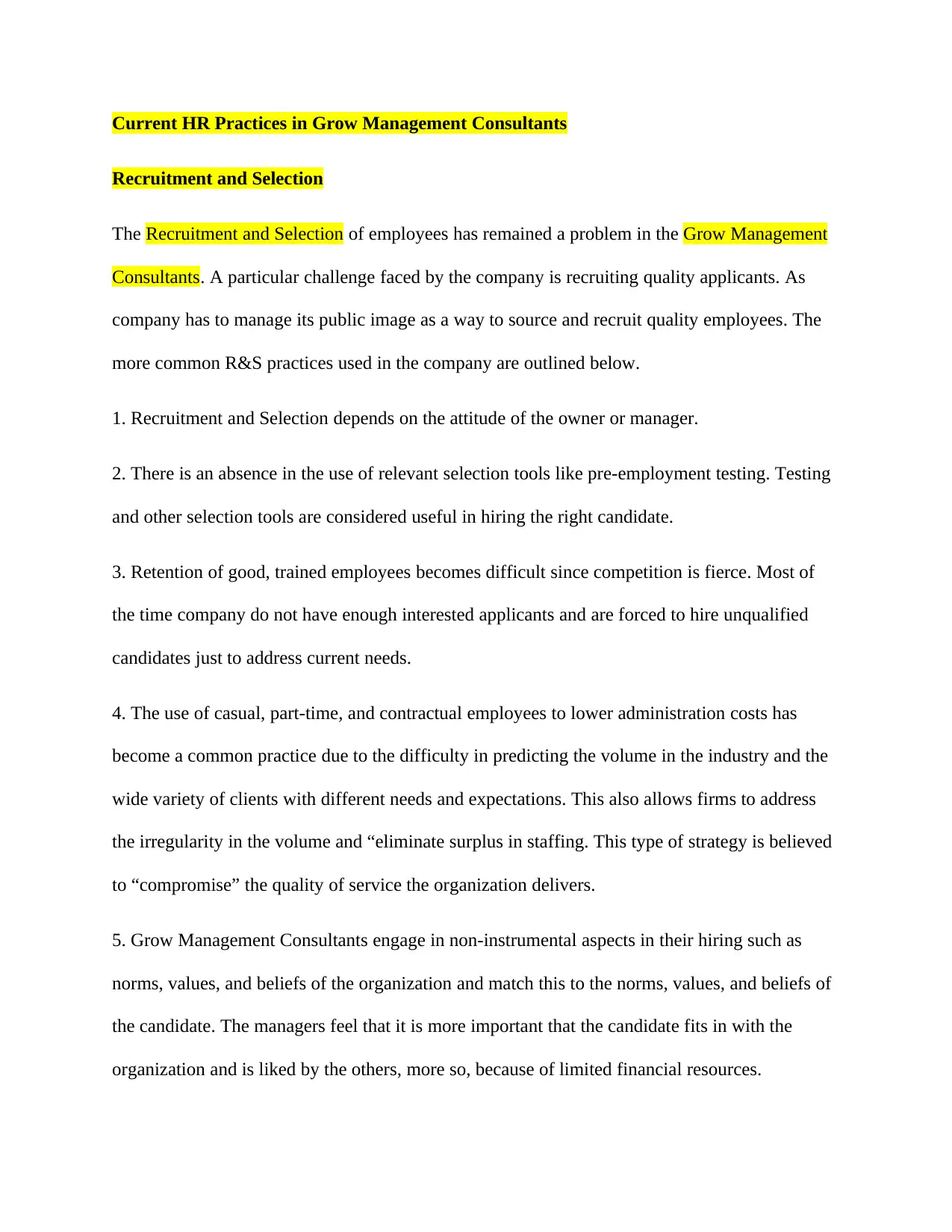
Current HR Practices in Grow Management Consultants
Recruitment and Selection
The Recruitment and Selection of employees has remained a problem in the Grow Management
Consultants. A particular challenge faced by the company is recruiting quality applicants. As
company has to manage its public image as a way to source and recruit quality employees. The
more common R&S practices used in the company are outlined below.
1. Recruitment and Selection depends on the attitude of the owner or manager.
2. There is an absence in the use of relevant selection tools like pre-employment testing. Testing
and other selection tools are considered useful in hiring the right candidate.
3. Retention of good, trained employees becomes difficult since competition is fierce. Most of
the time company do not have enough interested applicants and are forced to hire unqualified
candidates just to address current needs.
4. The use of casual, part-time, and contractual employees to lower administration costs has
become a common practice due to the difficulty in predicting the volume in the industry and the
wide variety of clients with different needs and expectations. This also allows firms to address
the irregularity in the volume and “eliminate surplus in staffing. This type of strategy is believed
to “compromise” the quality of service the organization delivers.
5. Grow Management Consultants engage in non-instrumental aspects in their hiring such as
norms, values, and beliefs of the organization and match this to the norms, values, and beliefs of
the candidate. The managers feel that it is more important that the candidate fits in with the
organization and is liked by the others, more so, because of limited financial resources.
Recruitment and Selection
The Recruitment and Selection of employees has remained a problem in the Grow Management
Consultants. A particular challenge faced by the company is recruiting quality applicants. As
company has to manage its public image as a way to source and recruit quality employees. The
more common R&S practices used in the company are outlined below.
1. Recruitment and Selection depends on the attitude of the owner or manager.
2. There is an absence in the use of relevant selection tools like pre-employment testing. Testing
and other selection tools are considered useful in hiring the right candidate.
3. Retention of good, trained employees becomes difficult since competition is fierce. Most of
the time company do not have enough interested applicants and are forced to hire unqualified
candidates just to address current needs.
4. The use of casual, part-time, and contractual employees to lower administration costs has
become a common practice due to the difficulty in predicting the volume in the industry and the
wide variety of clients with different needs and expectations. This also allows firms to address
the irregularity in the volume and “eliminate surplus in staffing. This type of strategy is believed
to “compromise” the quality of service the organization delivers.
5. Grow Management Consultants engage in non-instrumental aspects in their hiring such as
norms, values, and beliefs of the organization and match this to the norms, values, and beliefs of
the candidate. The managers feel that it is more important that the candidate fits in with the
organization and is liked by the others, more so, because of limited financial resources.
Secure Best Marks with AI Grader
Need help grading? Try our AI Grader for instant feedback on your assignments.
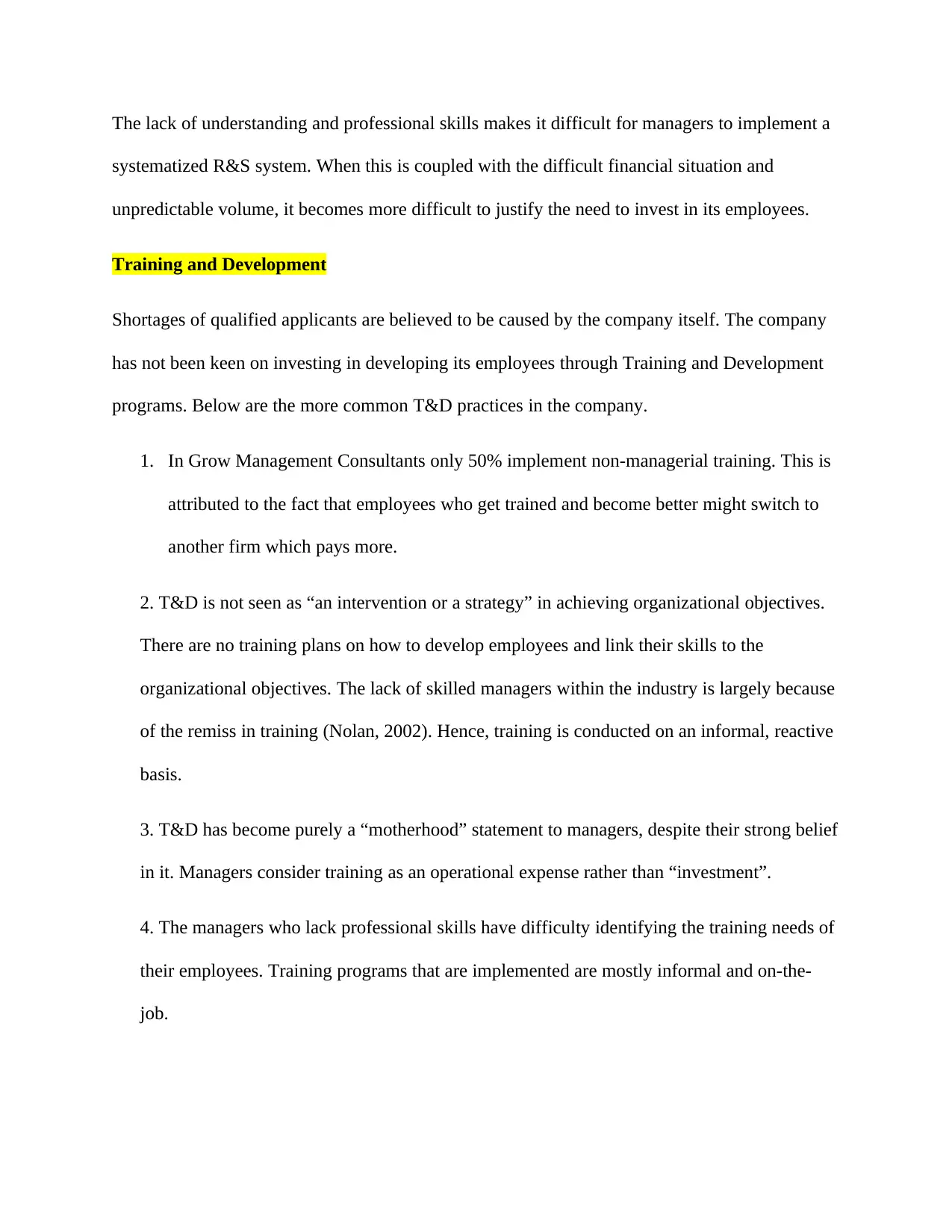
The lack of understanding and professional skills makes it difficult for managers to implement a
systematized R&S system. When this is coupled with the difficult financial situation and
unpredictable volume, it becomes more difficult to justify the need to invest in its employees.
Training and Development
Shortages of qualified applicants are believed to be caused by the company itself. The company
has not been keen on investing in developing its employees through Training and Development
programs. Below are the more common T&D practices in the company.
1. In Grow Management Consultants only 50% implement non-managerial training. This is
attributed to the fact that employees who get trained and become better might switch to
another firm which pays more.
2. T&D is not seen as “an intervention or a strategy” in achieving organizational objectives.
There are no training plans on how to develop employees and link their skills to the
organizational objectives. The lack of skilled managers within the industry is largely because
of the remiss in training (Nolan, 2002). Hence, training is conducted on an informal, reactive
basis.
3. T&D has become purely a “motherhood” statement to managers, despite their strong belief
in it. Managers consider training as an operational expense rather than “investment”.
4. The managers who lack professional skills have difficulty identifying the training needs of
their employees. Training programs that are implemented are mostly informal and on-the-
job.
systematized R&S system. When this is coupled with the difficult financial situation and
unpredictable volume, it becomes more difficult to justify the need to invest in its employees.
Training and Development
Shortages of qualified applicants are believed to be caused by the company itself. The company
has not been keen on investing in developing its employees through Training and Development
programs. Below are the more common T&D practices in the company.
1. In Grow Management Consultants only 50% implement non-managerial training. This is
attributed to the fact that employees who get trained and become better might switch to
another firm which pays more.
2. T&D is not seen as “an intervention or a strategy” in achieving organizational objectives.
There are no training plans on how to develop employees and link their skills to the
organizational objectives. The lack of skilled managers within the industry is largely because
of the remiss in training (Nolan, 2002). Hence, training is conducted on an informal, reactive
basis.
3. T&D has become purely a “motherhood” statement to managers, despite their strong belief
in it. Managers consider training as an operational expense rather than “investment”.
4. The managers who lack professional skills have difficulty identifying the training needs of
their employees. Training programs that are implemented are mostly informal and on-the-
job.
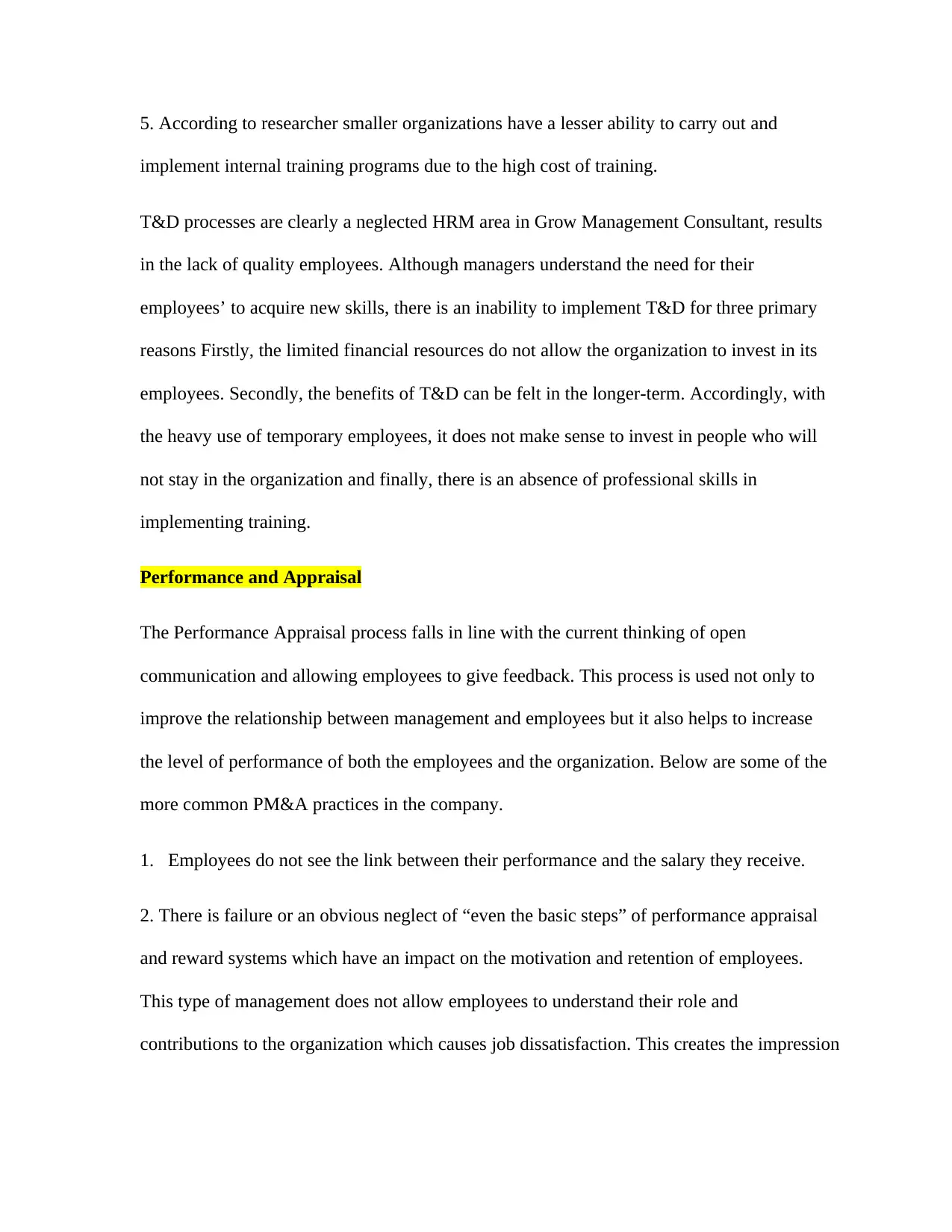
5. According to researcher smaller organizations have a lesser ability to carry out and
implement internal training programs due to the high cost of training.
T&D processes are clearly a neglected HRM area in Grow Management Consultant, results
in the lack of quality employees. Although managers understand the need for their
employees’ to acquire new skills, there is an inability to implement T&D for three primary
reasons Firstly, the limited financial resources do not allow the organization to invest in its
employees. Secondly, the benefits of T&D can be felt in the longer-term. Accordingly, with
the heavy use of temporary employees, it does not make sense to invest in people who will
not stay in the organization and finally, there is an absence of professional skills in
implementing training.
Performance and Appraisal
The Performance Appraisal process falls in line with the current thinking of open
communication and allowing employees to give feedback. This process is used not only to
improve the relationship between management and employees but it also helps to increase
the level of performance of both the employees and the organization. Below are some of the
more common PM&A practices in the company.
1. Employees do not see the link between their performance and the salary they receive.
2. There is failure or an obvious neglect of “even the basic steps” of performance appraisal
and reward systems which have an impact on the motivation and retention of employees.
This type of management does not allow employees to understand their role and
contributions to the organization which causes job dissatisfaction. This creates the impression
implement internal training programs due to the high cost of training.
T&D processes are clearly a neglected HRM area in Grow Management Consultant, results
in the lack of quality employees. Although managers understand the need for their
employees’ to acquire new skills, there is an inability to implement T&D for three primary
reasons Firstly, the limited financial resources do not allow the organization to invest in its
employees. Secondly, the benefits of T&D can be felt in the longer-term. Accordingly, with
the heavy use of temporary employees, it does not make sense to invest in people who will
not stay in the organization and finally, there is an absence of professional skills in
implementing training.
Performance and Appraisal
The Performance Appraisal process falls in line with the current thinking of open
communication and allowing employees to give feedback. This process is used not only to
improve the relationship between management and employees but it also helps to increase
the level of performance of both the employees and the organization. Below are some of the
more common PM&A practices in the company.
1. Employees do not see the link between their performance and the salary they receive.
2. There is failure or an obvious neglect of “even the basic steps” of performance appraisal
and reward systems which have an impact on the motivation and retention of employees.
This type of management does not allow employees to understand their role and
contributions to the organization which causes job dissatisfaction. This creates the impression
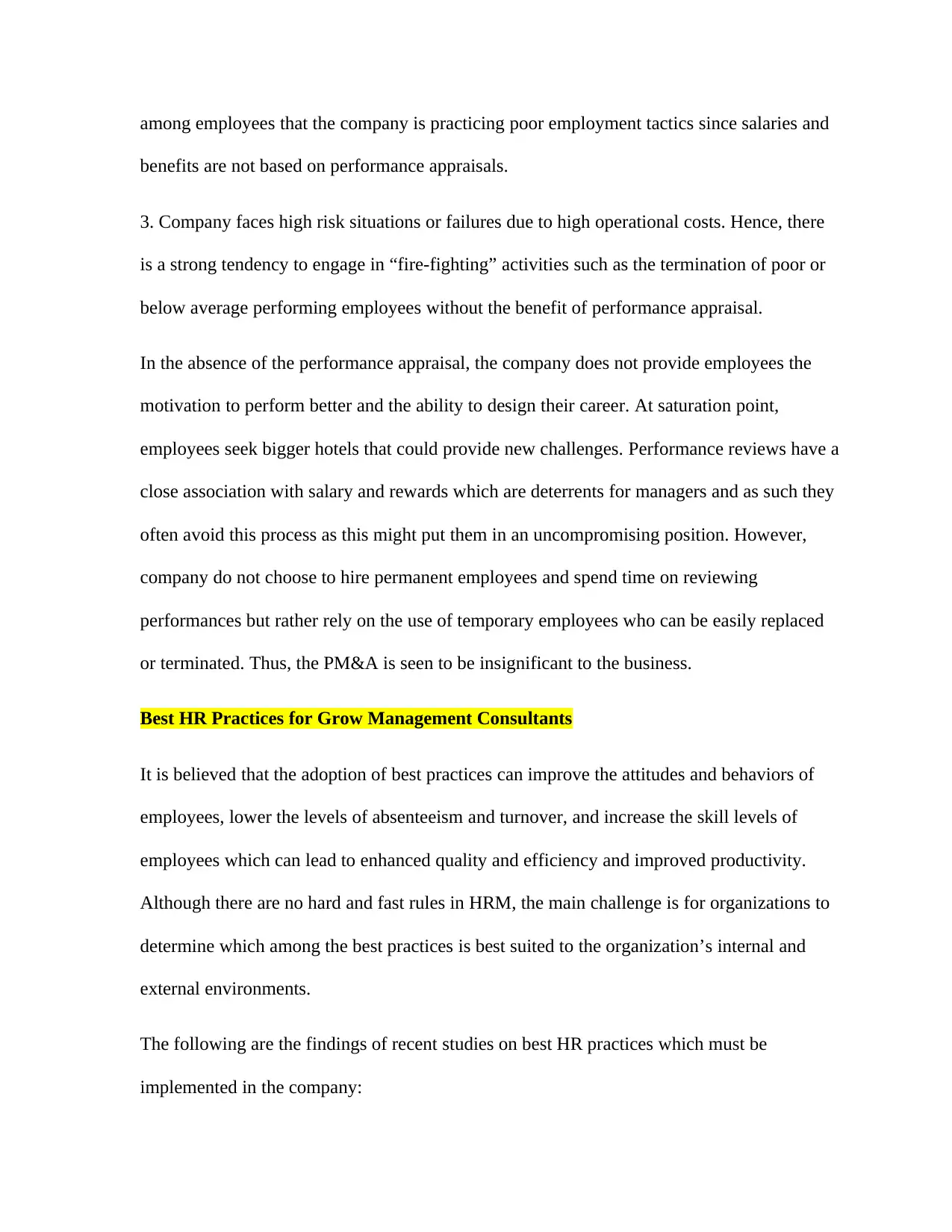
among employees that the company is practicing poor employment tactics since salaries and
benefits are not based on performance appraisals.
3. Company faces high risk situations or failures due to high operational costs. Hence, there
is a strong tendency to engage in “fire-fighting” activities such as the termination of poor or
below average performing employees without the benefit of performance appraisal.
In the absence of the performance appraisal, the company does not provide employees the
motivation to perform better and the ability to design their career. At saturation point,
employees seek bigger hotels that could provide new challenges. Performance reviews have a
close association with salary and rewards which are deterrents for managers and as such they
often avoid this process as this might put them in an uncompromising position. However,
company do not choose to hire permanent employees and spend time on reviewing
performances but rather rely on the use of temporary employees who can be easily replaced
or terminated. Thus, the PM&A is seen to be insignificant to the business.
Best HR Practices for Grow Management Consultants
It is believed that the adoption of best practices can improve the attitudes and behaviors of
employees, lower the levels of absenteeism and turnover, and increase the skill levels of
employees which can lead to enhanced quality and efficiency and improved productivity.
Although there are no hard and fast rules in HRM, the main challenge is for organizations to
determine which among the best practices is best suited to the organization’s internal and
external environments.
The following are the findings of recent studies on best HR practices which must be
implemented in the company:
benefits are not based on performance appraisals.
3. Company faces high risk situations or failures due to high operational costs. Hence, there
is a strong tendency to engage in “fire-fighting” activities such as the termination of poor or
below average performing employees without the benefit of performance appraisal.
In the absence of the performance appraisal, the company does not provide employees the
motivation to perform better and the ability to design their career. At saturation point,
employees seek bigger hotels that could provide new challenges. Performance reviews have a
close association with salary and rewards which are deterrents for managers and as such they
often avoid this process as this might put them in an uncompromising position. However,
company do not choose to hire permanent employees and spend time on reviewing
performances but rather rely on the use of temporary employees who can be easily replaced
or terminated. Thus, the PM&A is seen to be insignificant to the business.
Best HR Practices for Grow Management Consultants
It is believed that the adoption of best practices can improve the attitudes and behaviors of
employees, lower the levels of absenteeism and turnover, and increase the skill levels of
employees which can lead to enhanced quality and efficiency and improved productivity.
Although there are no hard and fast rules in HRM, the main challenge is for organizations to
determine which among the best practices is best suited to the organization’s internal and
external environments.
The following are the findings of recent studies on best HR practices which must be
implemented in the company:
Secure Best Marks with AI Grader
Need help grading? Try our AI Grader for instant feedback on your assignments.
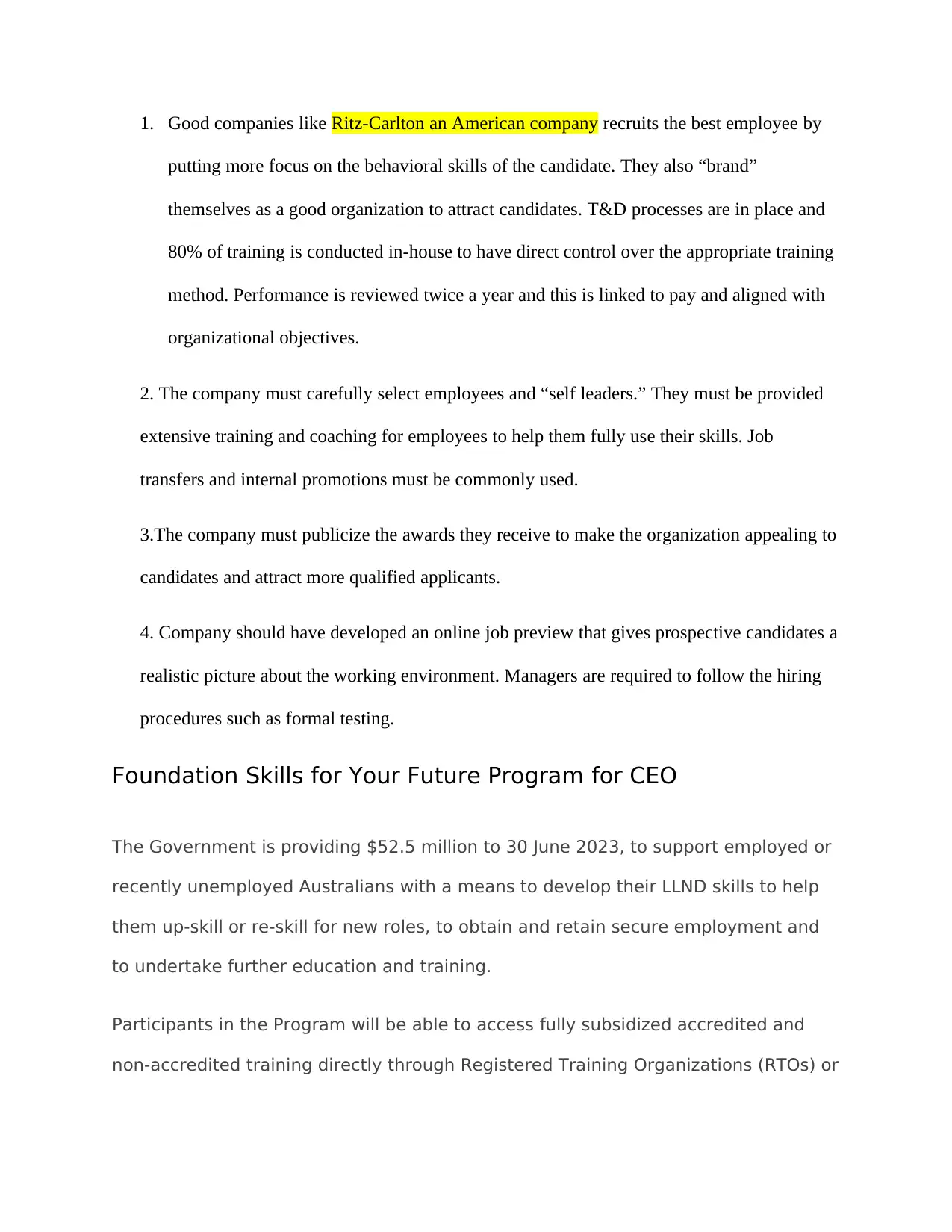
1. Good companies like Ritz-Carlton an American company recruits the best employee by
putting more focus on the behavioral skills of the candidate. They also “brand”
themselves as a good organization to attract candidates. T&D processes are in place and
80% of training is conducted in-house to have direct control over the appropriate training
method. Performance is reviewed twice a year and this is linked to pay and aligned with
organizational objectives.
2. The company must carefully select employees and “self leaders.” They must be provided
extensive training and coaching for employees to help them fully use their skills. Job
transfers and internal promotions must be commonly used.
3.The company must publicize the awards they receive to make the organization appealing to
candidates and attract more qualified applicants.
4. Company should have developed an online job preview that gives prospective candidates a
realistic picture about the working environment. Managers are required to follow the hiring
procedures such as formal testing.
Foundation Skills for Your Future Program for CEO
The Government is providing $52.5 million to 30 June 2023, to support employed or
recently unemployed Australians with a means to develop their LLND skills to help
them up-skill or re-skill for new roles, to obtain and retain secure employment and
to undertake further education and training.
Participants in the Program will be able to access fully subsidized accredited and
non-accredited training directly through Registered Training Organizations (RTOs) or
putting more focus on the behavioral skills of the candidate. They also “brand”
themselves as a good organization to attract candidates. T&D processes are in place and
80% of training is conducted in-house to have direct control over the appropriate training
method. Performance is reviewed twice a year and this is linked to pay and aligned with
organizational objectives.
2. The company must carefully select employees and “self leaders.” They must be provided
extensive training and coaching for employees to help them fully use their skills. Job
transfers and internal promotions must be commonly used.
3.The company must publicize the awards they receive to make the organization appealing to
candidates and attract more qualified applicants.
4. Company should have developed an online job preview that gives prospective candidates a
realistic picture about the working environment. Managers are required to follow the hiring
procedures such as formal testing.
Foundation Skills for Your Future Program for CEO
The Government is providing $52.5 million to 30 June 2023, to support employed or
recently unemployed Australians with a means to develop their LLND skills to help
them up-skill or re-skill for new roles, to obtain and retain secure employment and
to undertake further education and training.
Participants in the Program will be able to access fully subsidized accredited and
non-accredited training directly through Registered Training Organizations (RTOs) or
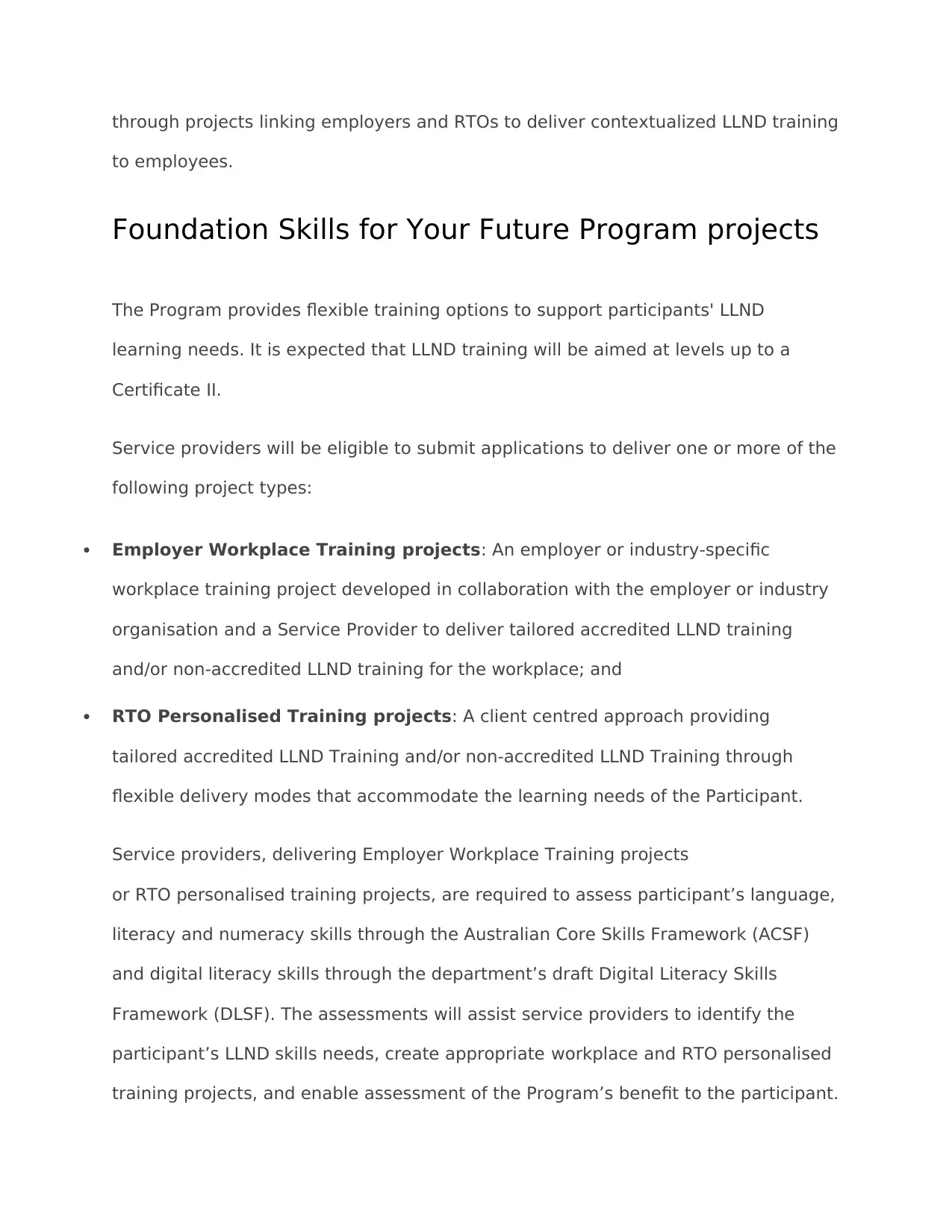
through projects linking employers and RTOs to deliver contextualized LLND training
to employees.
Foundation Skills for Your Future Program projects
The Program provides flexible training options to support participants' LLND
learning needs. It is expected that LLND training will be aimed at levels up to a
Certificate II.
Service providers will be eligible to submit applications to deliver one or more of the
following project types:
Employer Workplace Training projects: An employer or industry-specific
workplace training project developed in collaboration with the employer or industry
organisation and a Service Provider to deliver tailored accredited LLND training
and/or non-accredited LLND training for the workplace; and
RTO Personalised Training projects: A client centred approach providing
tailored accredited LLND Training and/or non-accredited LLND Training through
flexible delivery modes that accommodate the learning needs of the Participant.
Service providers, delivering Employer Workplace Training projects
or RTO personalised training projects, are required to assess participant’s language,
literacy and numeracy skills through the Australian Core Skills Framework (ACSF)
and digital literacy skills through the department’s draft Digital Literacy Skills
Framework (DLSF). The assessments will assist service providers to identify the
participant’s LLND skills needs, create appropriate workplace and RTO personalised
training projects, and enable assessment of the Program’s benefit to the participant.
to employees.
Foundation Skills for Your Future Program projects
The Program provides flexible training options to support participants' LLND
learning needs. It is expected that LLND training will be aimed at levels up to a
Certificate II.
Service providers will be eligible to submit applications to deliver one or more of the
following project types:
Employer Workplace Training projects: An employer or industry-specific
workplace training project developed in collaboration with the employer or industry
organisation and a Service Provider to deliver tailored accredited LLND training
and/or non-accredited LLND training for the workplace; and
RTO Personalised Training projects: A client centred approach providing
tailored accredited LLND Training and/or non-accredited LLND Training through
flexible delivery modes that accommodate the learning needs of the Participant.
Service providers, delivering Employer Workplace Training projects
or RTO personalised training projects, are required to assess participant’s language,
literacy and numeracy skills through the Australian Core Skills Framework (ACSF)
and digital literacy skills through the department’s draft Digital Literacy Skills
Framework (DLSF). The assessments will assist service providers to identify the
participant’s LLND skills needs, create appropriate workplace and RTO personalised
training projects, and enable assessment of the Program’s benefit to the participant.
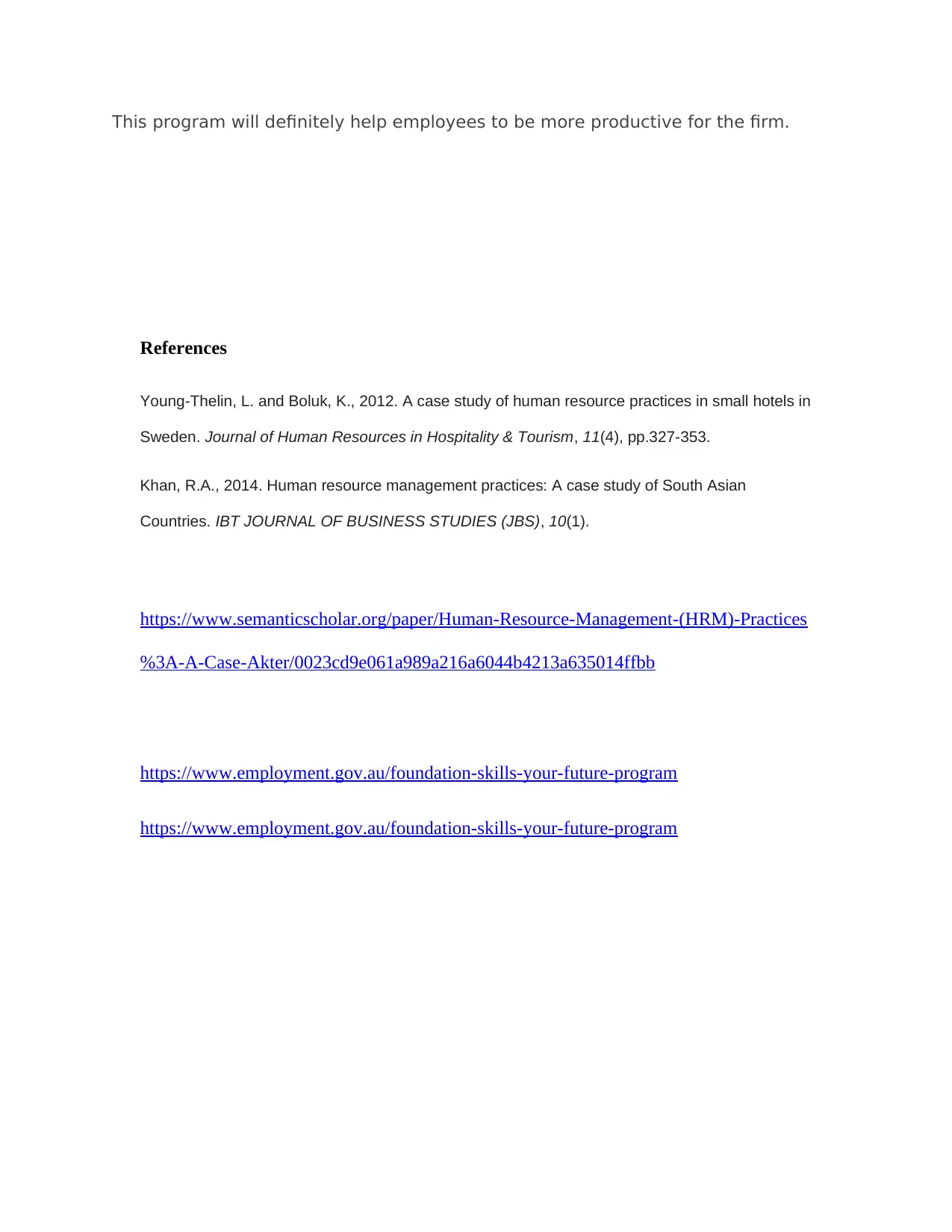
This program will definitely help employees to be more productive for the firm.
References
Young-Thelin, L. and Boluk, K., 2012. A case study of human resource practices in small hotels in
Sweden. Journal of Human Resources in Hospitality & Tourism, 11(4), pp.327-353.
Khan, R.A., 2014. Human resource management practices: A case study of South Asian
Countries. IBT JOURNAL OF BUSINESS STUDIES (JBS), 10(1).
https://www.semanticscholar.org/paper/Human-Resource-Management-(HRM)-Practices
%3A-A-Case-Akter/0023cd9e061a989a216a6044b4213a635014ffbb
https://www.employment.gov.au/foundation-skills-your-future-program
https://www.employment.gov.au/foundation-skills-your-future-program
References
Young-Thelin, L. and Boluk, K., 2012. A case study of human resource practices in small hotels in
Sweden. Journal of Human Resources in Hospitality & Tourism, 11(4), pp.327-353.
Khan, R.A., 2014. Human resource management practices: A case study of South Asian
Countries. IBT JOURNAL OF BUSINESS STUDIES (JBS), 10(1).
https://www.semanticscholar.org/paper/Human-Resource-Management-(HRM)-Practices
%3A-A-Case-Akter/0023cd9e061a989a216a6044b4213a635014ffbb
https://www.employment.gov.au/foundation-skills-your-future-program
https://www.employment.gov.au/foundation-skills-your-future-program
1 out of 7
Related Documents
Your All-in-One AI-Powered Toolkit for Academic Success.
+13062052269
info@desklib.com
Available 24*7 on WhatsApp / Email
![[object Object]](/_next/static/media/star-bottom.7253800d.svg)
Unlock your academic potential
© 2024 | Zucol Services PVT LTD | All rights reserved.





